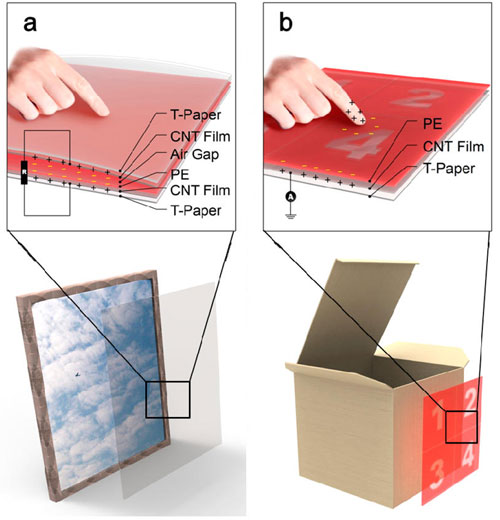| Posted: Jul 13, 2015 | |
Towards self-powered electronic papers |
|
| (Nanowerk Spotlight) Paper as you know it is going to change. Various research efforts are about to make paper 'smart'. Take the European ROPAS project which aims to develop a wireless sensor device on a paper surface which can be manufactured using high-end and low-cost printing techniques. Researchers have also already demonstrated various types of devices on paper – batteries ("Truly green paper battery is algae-powered"), solar cells ("Mass-printed polymer/fullerene solar cells on paper"), RFID tags ("Playing RFID tag with sheets of paper"), or transistors ("Nanopaper transistors for the coming age of flexible and transparent electronics"). | |
| Taking these developments a step further, an international research team has designed and demonstrated novel self-powered human-interactive transparent nanopaper systems, utilizing transparent nanopaper as base material. | |
| The team, led by Jun Zhou, a professor at the Wuhan National Laboratory for Optoelectronics, and School of Optical and Electronic Information, Huazhong University of Science and Technology, and Liangbing Hu, an Assistant Professor in the Department of Materials Science and Engineering & Energy Research Center at the University of Maryland, reported their findings in the June 29, 2015 online edition of ACS NANO ("Self-Powered Human-Interactive Transparent Nanopaper Systems"). | |
| "Our nanopaper system is based on an electrostatic induction mechanism and a dielectric material," Zhou tells to Nanowerk. "That makes it self-powered, i.e. able to operate without the need for external power." | |
| These so-called electret materials – the word is a combination of elektr from 'electricity' and et from 'magnet' – have the ability to store residual charges for rather a long time. This new approach to energy harvesting is already are used in microphones and in MEMS devices, but these usually are solid devices. A recent example for a flexible application has been a paper generator. | |
| The team's Transparent Paper-Based Flexible Generator (TPFG) basically consists of two transparent electrode components: two sheets of nanopaper coated with carbon nanotubes (CNTs) where one of the sheets additionally is covered with a 30 µm polyethylene (PE) film, a transparent and non-fluorine electret. The two sheets are then joined together on their coated sides (the PE facing the CNTs). | |
| The basic working mechanisms of the resulting devices are electrostatic induction effects caused by the retaining charges. | |
| "The variation of the air gap between the two components has a key role in the generation of the alternating electric currents," Zhou explains. "When the TPFG is in the original – equilibrium – state, no free electrons will flow in the external circuit. However, when a vertical compression is applied to the TPFG, the air gap becomes smaller and more positive charges will be induced in the bottom CNT electrode. As a result, the equilibrium state is broken and current will flow from the top CNT electrode to the bottom CNT electrode." | |
| Charges will accumulate in the bottom electrode until a new equilibrium is reached and the current stops flowing. When the pressure is released, the process reverses: the air gap increases and the current starts to flow again in the other direction until again an equilibrium has been reached. | |
 |
|
| Schematic diagram for (a) transparent paper-based art anti-theft system and (b) transparent paper-based smart mapping anti-fake system. The transparent paper-based art anti-theft system may be applied to protect valuable art in museums, and the transparent paper-based smart mapping anti-fake system may have applications in smart packaging or important documents. (Reprinted with permission by American Chemical Society) | |
| "Our transparent nanopaper system could potentially be manufactured at a large scale for practical applications," says Hu. "To demonstrate this, we have fabricated TPFG anti-theft and anti-fake systems." | |
| He explains that the anti-theft system will not affect the appearance of the art and is also sensitive for detecting external pressure. Additionally, the system is compatible with paper arts and can be added or removed freely. | |
| In a similar vein, the anti-fake system based on transparent nanopaper displays coded information – a date, ID number, etc. – which may have potential applications in the smart packaging of important documents, such as wills and birth certificates, or as product labels. | |
| The researchers are now working on improving their device, especially with regard to long-term stability and device integration (e.g. RFIDs). Furthermore, currently the output stability of the generator can be affected when the device works in a high humidity environment. Also, the carbon nanotube electrodes could pose a potential health concern if these devices are integrated into electronic skin applications and therefore the team is thinking about using other types of electret materials and conductive layer composed of silver nanowires or conductive polymers. | |
 By
Michael
Berger
– Michael is author of three books by the Royal Society of Chemistry:
Nano-Society: Pushing the Boundaries of Technology,
Nanotechnology: The Future is Tiny, and
Nanoengineering: The Skills and Tools Making Technology Invisible
Copyright ©
Nanowerk LLC
By
Michael
Berger
– Michael is author of three books by the Royal Society of Chemistry:
Nano-Society: Pushing the Boundaries of Technology,
Nanotechnology: The Future is Tiny, and
Nanoengineering: The Skills and Tools Making Technology Invisible
Copyright ©
Nanowerk LLC
|
|
|
Become a Spotlight guest author! Join our large and growing group of guest contributors. Have you just published a scientific paper or have other exciting developments to share with the nanotechnology community? Here is how to publish on nanowerk.com. |
|
